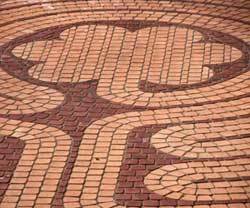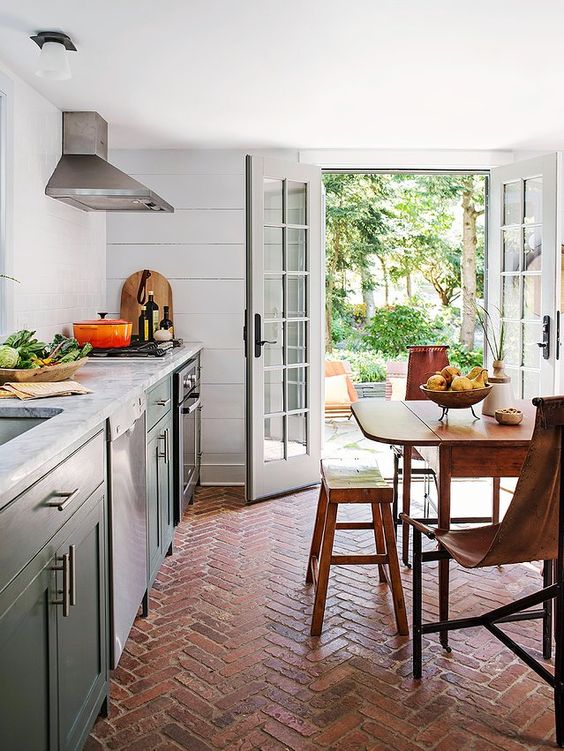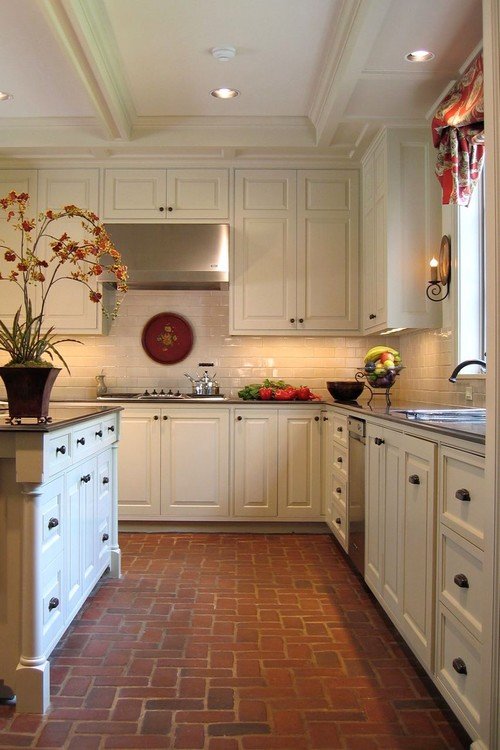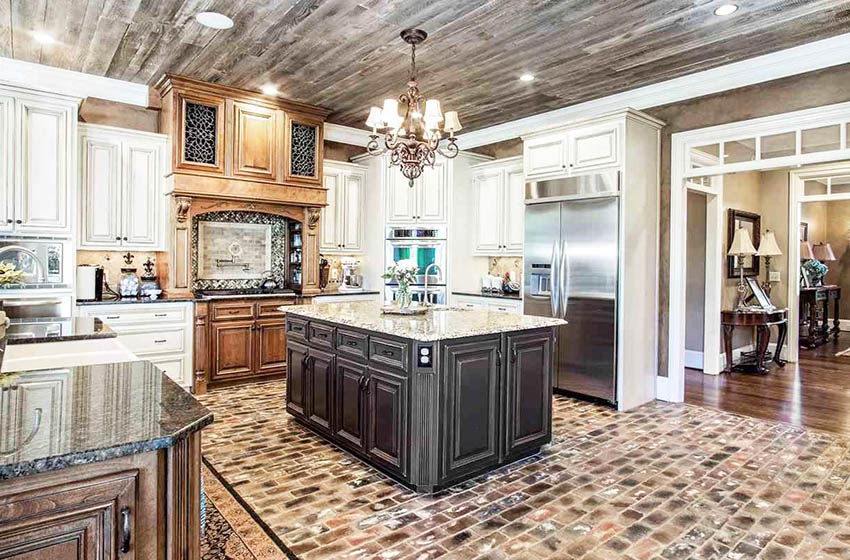Steps to Take Before Cleaning Your Brick Kitchen Floor
Before diving into the process of cleaning your brick kitchen floor, it’s essential to prepare adequately. Taking the right steps beforehand will ensure a smoother and more effective cleaning process. We will discuss the important steps to take before cleaning your brick kitchen floor.
- Clear the Area: Start by removing any furniture, appliances, or rugs from the floor. This will give you a clear and unobstructed space to work with. Additionally, it will prevent any damage to your belongings during the cleaning process.
- Sweep or Vacuum: Next, use a broom or vacuum cleaner to remove loose dirt, dust, and debris from the surface of the brick floor. Pay special attention to the corners and crevices where dirt tends to accumulate. Removing loose particles beforehand will make the cleaning process more effective.
- Test for Stains: Before applying any cleaning solution, it’s important to identify any stubborn stains on the brick floor. Perform a spot test in a discreet area using a mild cleaning solution to determine the best method for removing the stains. This will prevent any potential damage to the floor during the cleaning process.
- Gather Protective Gear: Cleaning brick floors can be a messy task, so it’s essential to protect yourself. Wear gloves, safety goggles, and a face mask to shield yourself from any potential irritants or fumes. This precautionary measure will ensure your safety throughout the cleaning process.
- Ventilate the Area: Brick floors can release dust and particles into the air during the cleaning process. To prevent the accumulation of fumes or dust, open windows and turn on fans to improve ventilation. Proper airflow will help in maintaining a healthy and comfortable environment while cleaning.
- Prepare Cleaning Solutions: Depending on the condition of your brick kitchen floor, choose the appropriate cleaning solution. Whether it’s a mild detergent, vinegar, and water mixture, or a specialized brick cleaner, ensure that your cleaning solution is safe for use on brick surfaces. Follow the manufacturer’s instructions for dilution ratios, if applicable.

Choosing the Right Cleaning Solution
When it comes to cleaning a brick kitchen floor, choosing the right cleaning solution is crucial. The type of solution you use will depend on the condition of your floor and the level of grime or stains present. Here are the best methods for cleaning a brick kitchen floor and the different cleaning solutions available.
Mild Detergent: A mild detergent solution is often the safest and most effective option for cleaning brick floors. Mix a small amount of mild dish soap or a pH-neutral cleaner with warm water. Apply the solution to the brick floor using a mop or a soft-bristle brush. Gently scrub the surface, focusing on stained or dirty areas. Rinse thoroughly with clean water afterward.
Vinegar and Water Mixture: Vinegar is a natural cleaning agent that can effectively remove dirt and grease from brick surfaces. Mix equal parts white vinegar and water in a bucket. Apply the solution to the floor and scrub gently. Allow the mixture to sit on the surface for a few minutes before rinsing with clean water. Note that vinegar may not be suitable for all types of brick, so test it in a small area first.
Commercial Brick Cleaner: For tougher stains or deep cleaning, consider using a commercial brick cleaner specifically formulated for brick surfaces. These cleaners are designed to break down stubborn dirt, grease, and grime. Follow the manufacturer’s instructions for proper usage and dilution ratios. Be sure to wear protective gear and ventilate the area when using commercial cleaners.
Pressure Washing: In some cases, a pressure washer can be used to clean a heavily soiled brick kitchen floor. However, exercise caution when using this method, as excessive pressure can damage the brick surface. Adjust the pressure to a gentle setting and maintain a safe distance from the floor. Always start with the lowest pressure and increase gradually if necessary.
Avoid Harsh Chemicals: When cleaning a brick kitchen floor, it’s important to avoid harsh chemicals such as bleach or ammonia-based cleaners. These chemicals can damage the brick and alter its natural appearance. Stick to mild or natural cleaning solutions to ensure the longevity and beauty of your brick floor.
Essential Items for Cleaning Your Brick Kitchen Floor
To effectively clean a brick kitchen floor, having the right tools and equipment is essential. These tools will help you remove dirt, stains, and grime from the surface of the bricks. We will discuss the essential items you will need to clean your brick kitchen floor.
Broom or Vacuum Cleaner: A broom or vacuum cleaner is necessary to remove loose dirt, dust, and debris from the floor before cleaning. Use a broom with stiff bristles or a vacuum cleaner with a brush attachment to ensure the thorough removal of particles from the surface and crevices of the brick floor.
Soft-Bristle Brush: A soft-bristle brush is a valuable tool for scrubbing the brick surface during the cleaning process. It helps to loosen dirt and grime without scratching or damaging the bricks. Choose a brush with bristles that are gentle yet effective in removing stains and debris from the surface of the bricks.
Mop or Sponge: A mop or sponge is essential for applying cleaning solutions to the brick floor. Opt for a mop with a microfiber or cotton head, as these materials are effective at absorbing and distributing the cleaning solution evenly across the floor. If using a sponge, make sure it is clean and in good condition.
Bucket: A bucket is necessary for mixing cleaning solutions and water. It allows you to have a ready supply of the cleaning solution while you clean. Choose a sturdy bucket with a comfortable handle that can hold an adequate amount of solution for the size of your brick kitchen floor.
Protective Gear: Protective gear, such as gloves, safety goggles, and a face mask, is crucial when cleaning a brick kitchen floor. Gloves protect your hands from chemicals and rough surfaces, goggles shield your eyes from debris and cleaning solutions, and a face mask helps filter out any dust or fumes that may be released during the cleaning process.
Soft Cloths or Towels: Soft cloths or towels are useful for drying the brick floor after cleaning. They absorb excess moisture and prevent water spots or streaks from forming on the surface of the bricks. Choose lint-free and absorbent cloths or towels to achieve the best results.
A Detailed Guide to Cleaning Your Brick Kitchen Floor
Cleaning a brick kitchen floor requires a systematic approach to ensure thoroughness and efficiency. Follow this a step-by-step guide to cleaning your brick kitchen floor, from preparing the area to the final drying process.
Clear the Area: Remove any furniture, appliances, or rugs from the floor to create an unobstructed workspace. This will allow you to clean the entire surface of the brick floor without any hindrances.
Sweep or Vacuum: Use a broom or vacuum cleaner with a brush attachment to remove loose dirt, dust, and debris from the surface of the floor. Pay special attention to corners and crevices where dirt tends to accumulate. This step will make the subsequent cleaning process more effective.
Pre-Treat Stains: Identify any stubborn stains on the brick floor and pre-treat them before proceeding with the general cleaning. Follow the manufacturer’s instructions for the appropriate stain remover or cleaning solution. Apply it to the stained areas and allow it to sit for a few minutes to break down the stain.
Prepare the Cleaning Solution: Depending on the condition of your brick kitchen floor, choose the appropriate cleaning solution. Whether it’s a mild detergent, vinegar and water mixture, or a specialized brick cleaner, follow the manufacturer’s instructions for dilution ratios. Mix the cleaning solution in a bucket according to the recommended proportions.
Apply the Cleaning Solution: Dip a mop or sponge into the cleaning solution, wring out any excess liquid, and apply it to the brick floor. Work in small sections to ensure that the cleaning solution does not dry out before you can scrub the surface. Use a soft-bristle brush to scrub the bricks, focusing on stained or dirty areas. Avoid excessive scrubbing, as it may damage the brick surface.
Rinse the Floor: After scrubbing the brick floor, rinse it thoroughly with clean water. This will remove any residual cleaning solution and dirt from the surface. Use a mop or sponge dampened with clean water to rinse the floor. Change the water as needed to ensure that you are using clean water for rinsing.
Dry the Floor: Once the floor is rinsed, use soft cloths or towels to dry it thoroughly. Absorb any excess moisture to prevent water spots or streaks from forming on the surface of the bricks. Allow the floor to air dry completely before placing furniture or rugs back in the kitchen.
Tips for Keeping Your Brick Kitchen Floor Clean and in Good Condition
Cleaning your brick kitchen floor is just one part of the equation. To keep it clean and in good condition, regular maintenance and preventive measures are crucial. Here are some helpful tips for maintaining and preventing dirt, stains, and damage on your brick kitchen floor.
Regular Sweeping or Vacuuming: Make it a habit to sweep or vacuum your brick kitchen floor regularly. This will help remove loose dirt, dust, and debris before they become ingrained in the surface of the bricks. Use a broom with stiff bristles or a vacuum cleaner with a brush attachment to effectively clean the floor.
Mop with Warm Water: For routine cleaning, mop the brick floor with warm water and a mild detergent. This will help remove any surface dirt or grime that has accumulated. Avoid using excessive amounts of water, as it can seep into the bricks and cause damage. Wring out the mop thoroughly before mopping the floor.
Wipe Spills Immediately: Spills on a brick kitchen floor should be wiped up immediately to prevent stains or damage. Use a clean cloth or paper towel to absorb the spill, and then clean the area with warm water and a mild detergent if necessary. Prompt action will minimize the likelihood of stains setting into the bricks.
Avoid Harsh Chemicals: When cleaning or maintaining your brick kitchen floor, avoid using harsh chemicals or abrasive cleaners. These can damage the bricks and alter their appearance. Stick to mild detergents and natural cleaning solutions to ensure the longevity and beauty of your brick floor.
Protect the Floor: Place mats or rugs in high traffic areas or in areas prone to spills to protect your brick kitchen floor. These protective coverings will help prevent dirt, scratches, and stains from directly affecting the surface of the bricks. Regularly clean and shake out the mats or rugs to remove any trapped dirt or debris.
Seal the Bricks: Consider applying a sealant to the bricks to provide an extra layer of protection. A brick sealant can help repel stains, moisture, and dirt, making it easier to clean and maintain your brick kitchen floor. Follow the manufacturer’s instructions for the application process and frequency of reapplication.
How to Clean Interior Brick Floors Brick flooring, How to clean
Tips for Installing Brick Floors – thewhitebuffalostylingco.com
Follow The Yellow Brick Home – Beautiful and Timeless Brick Floors
Follow The Yellow Brick Home – Beautiful and Timeless Brick Floors
Brick Flooring: Timeless Beauty in the Home Town u0026 Country Living
Kitchens – Inglenook Brick Tiles – Brick Pavers Thin Brick Tile
Things to Know Before Installing Brick Floors
Brick Flooring (Design u0026 Buying Guide) – Designing Idea
Related Posts:











